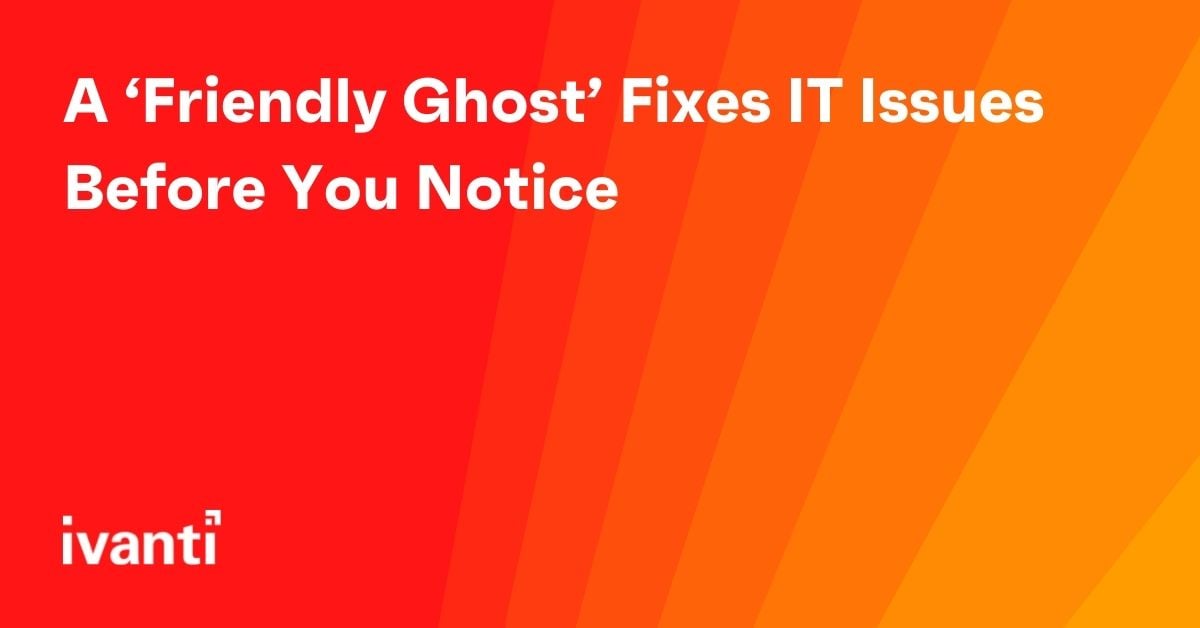A ‘Friendly Ghost’ Fixes IT Issues Before You Notice
Here in North America it’s that spooky time of the year again, Halloween. As always, children look forward to this late-October holiday, the chance to dress up in costumes to go door-to-door and amass large hauls of candy treats, leaving their parents to deal with any later ‘tricks’ from associated sugar highs.
In addition to the sweet tradition of ‘trick or treat’ it’s also a time when we think of witches, goblins and things that ‘go bump in the night.’ It reminds me of similar traditions and stories around the world.
For example, Poltergeist doesn’t just refer to a scary movie from 1982. In Germany it refers to particularly disruptive spirits making loud noises or moving things around a house, seemingly on their own. The desire to ward off Poltergeists might have given rise to another German tradition, Polterabend, where wedding guests break porcelain to bring good luck to a couple’s marriage. There are some origin references where the Polterabend tradition dates back to pre-medieval times when throwing pottery shards was thought to help drive off evil spirits and Poltergeists.
While things happening on their own makes for a key plot device in a scary movie, it doesn’t have to be scary in the IT world. New advances in automation — coupled with Artificial Intelligence (AI) and Machine Learning (ML) — are helping IT management solutions act more like friendly Poltergeists, ‘bumping’ things in helpful ways to deliver results such as fixing issues and potential problems before anyone notices. These next-generation automation capabilities promise to augment the capabilities of your service desk teams to deliver better outcomes that pleasantly treat your employees vs unplanned, disruptive tricks.
Examples always help me understand a new concept or solution. Let me share three examples how new automation capabilities could make it easier for IT teams to deliver better IT outcomes and end-user experiences (ghost-story imagery optional).
Someone to Watch Over Me
Do you always have to wait for employees to contact you about application issues? For example, let’s say Sharon has an application on her laptop that keeps crashing on her. It’s annoying, but Sharon doesn’t think it’s bad enough to contact IT since it crashes ‘only’ occasionally and she can just restart the offending application to keep working.
Instead, what if there was a bot checking for application crashes that could see Sharon’s crashes and alert the IT service desk. An IT agent could then contact Sharon and ask if she’d like some help to remediate her application issues. Rather than living with the annoyance from spotty crashes, Sharon would be pleasantly surprised by the unexpected help to make her work experience better.
Feels Like Something Was Holding Me Back
Do your employees sometimes call you complaining their laptop is running too slowly to get their work done? Let’s assume Paul is one of those employees whose laptop has been running slower and slower, until he finally calls the service desk about it. Your analyst spends some time with Paul to troubleshoot and finds the disk on Paul’s laptop is near capacity and needs to be cleaned up to free up some disk space.
But what if there was a bot checking regularly for things like limited free disk space? Like with Sharon’s issue, a bot could alert the service desk, but what if the bot could take some additional corrective action on its own — such actions as cleaning up Paul’s disk to immediately free up capacity before his laptop’s performance suffers? The bot could also alert Paul his laptop needs more free disk space — plus alert the service desk about Paul’s need. In the meantime, Paul can keep working without performance issues.
Who Opened That Door?
Do you have employees who sometimes open up a security vulnerability unintentionally? This third and final example is about Sam whose firewall is off.
Like in the previous two examples, a bot could be checking firewall status for several devices and see Sam’s firewall is off. Again, a bot could alert IT and also turn the firewall back on automatically, plugging a potential security hole. The bot could also message Sam about his firewall being off and prompt him for an IT service request if he would like some help should he have a specific need for his firewall to be off.
Taking the Service Experience to the Next Level
These three examples illustrate just some of the promise of next-generation IT solutions to help the IT service desk deliver better experiences and outcomes all around. You can probably come up with your own examples how you could radically improve the relationship with all employees by fixing issues and incidents before anyone notices. The technology has been expanding the ‘art of the possible’ to make these types of results a reality.
The Ivanti Neurons solution delivers these types of proactive capabilities, including deploying squads of automation-powered bots ready to catch and fix IT issues before anyone notices. Dozens of bots are available out-of-the-box to help IT teams get started quickly. Several IT teams have taken the next step of creating their own bots, sometimes incorporating PowerShell scripts, to meet specific needs and requirements.
One additional key capability is integration within the IT Service Management (ITSM) context. This makes it easy to log and keep track of all the activities and actions from these squads of bots, helping improve governance while also providing data for trend analysis for potential corrective actions or changes. One more benefit? Your IT team still gets the credit for the work bots do on your behalf.
I like to think of these squads of bots as a component of your IT Co-Pilot, augmenting your team’s capabilities to be more efficient and consistent in delivering high-quality services and outcomes. By automating much more of the routine yet important responsibilities, these bots help free up time so your team can better focus on the key work you’ve wanted to do, delivering better experiences and better outcomes all around.
And by the way, no need to smash your good porcelain to encourage good experiences from your ‘friendly’ IT Poltergeist.

